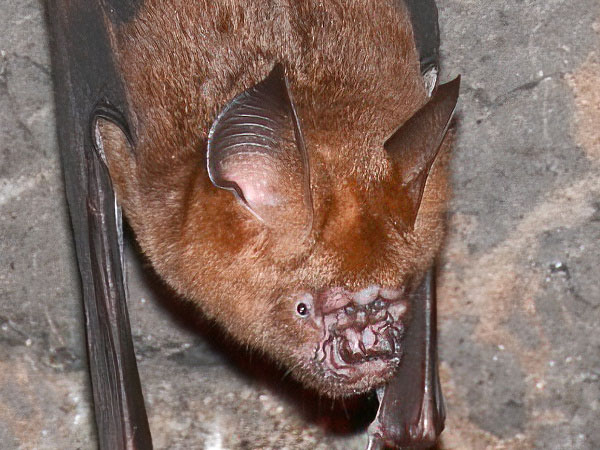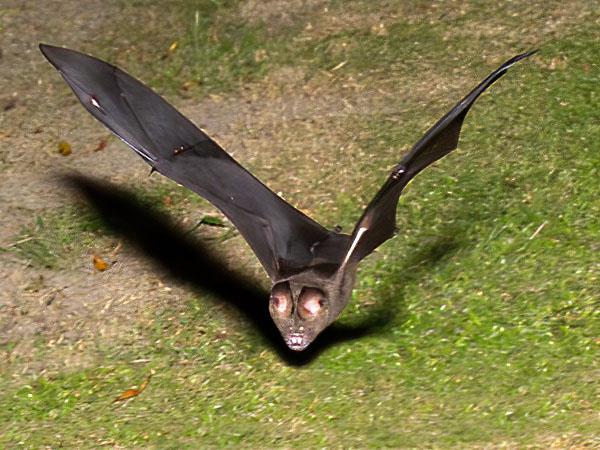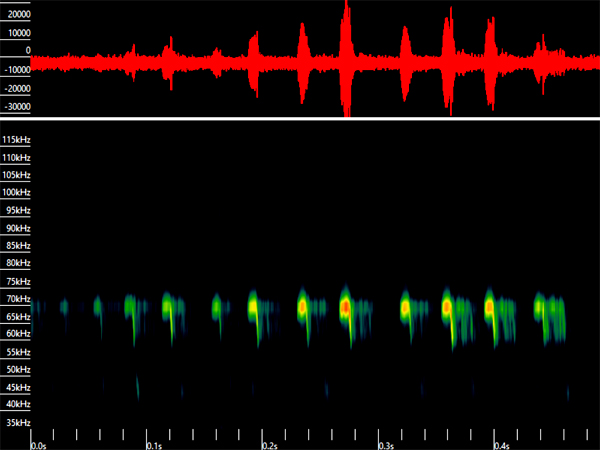
Fig 1

Fig 2

Fig 3

Fig 4

Fig 5

Fig 6
|
Order : CHIROPTERA
Family : Hipposideridae
Species : Hipposideros armiger
Forearm Length : up to 10..3 cm
Weight : up to 67 grams (Francis, 2019)
Roundleaf bats of the genus Hipposideros are insectivorous bats characterised by a
rounded noseleaf but, unlike the Rhinolophus horseshoe bats, they lack a
'lancet' or projection from the top of the noseleaf.
Hipposideros armiger
(Great Roundleaf Bat) is
amongst the largest bats of the genus, and is the largest
example in Southeast Asia. Typically this bat roosts in caves, but it may
also be found in spacious, abandoned buildings. It forages around trees and
adjacent open areas in search of flying insects, which it may consume whilst
clinging to a tree trunk.
The noseleaf has four lateral accessory leaflets on each side (although the outermost leaflet is often poorly developed). Males
also possess a fleshy, swollen area above and behind the noseleaf.
Its fur is thick and woolly, and varies in colour from dark brown to reddish
brown. The ears are dark brown.
This bat occurs in parts of eastern India, Nepal, southern China (including Taiwan), Vietnam, Laos, Cambodia, Myanmar,
Thailand and Peninsular
Malaysia. It has not been
recorded in Singapore.
A 2014 study of
Hipposideros armiger concluded that the geographic range of this
widespread species, and thus its genetic divergence, occurred as a result of
climatic changes in the Pleistocene epoch, particularly post-glacial,
male-based dispersal (Ai-Qing Lin et al, 2014)
This bat lends its name to the 'armiger species group' which includes
a small number of closely-related, but more geographically isolated, bats
including Hipposideros pendleburyi from peninsular Thailand and Hipposideros
alongensis from northern Vietnam (Francis, 2019).
Fig 1 : Female from Penang Island, Peninsular Malaysia, clinging to the
trunk of a coconut palm for a minute or so whilst foraging for insects.
Fig 2 : Female roosting in a limestone cave at Krabi, southern Thailand.
A large pup is taking shelter beneath her wing.
Fig 3 : The fleshy swellings above the noseleaf indicate this example to be
a male. This example is from Perlis, northern Peninsular Malaysia.
Figs 4 and 5 : Examples foraging for insects at dusk on Penang Island, Peninsular Malaysia;
one is skimming across a
grass lawn, and another is patrolling near a stand of bamboo.
Fig 6 : Example call of Hipposideros armiger from Perlis,
Peninsular Malaysia. The constant frequency (CF) component of this
recording has a maximum frequency of 69 kHz.
References :
Francis, C.M. 2019. A Field Guide to the Mammals of South-east Asia.
Second Edition. New Holland. 416 pp.
Lekagul, B., McNeely, J., 1977. Mammals of Thailand. Association for the
Conservation of Wildlife, Thailand. 758 pp.
Lin, A. Q., Csorba, G., Li, L. F., Jiang, T. L., Lu, G. J., Thong, V.
D., ... & Feng, J. (2014). Phylogeography of Hipposideros armiger
(Chiroptera: Hipposideridae) in the Oriental Region: the contribution of
multiple Pleistocene glacial refugia and intrinsic factors to
contemporary population genetic structure. Journal of Biogeography,
41(2), 317-327.
|